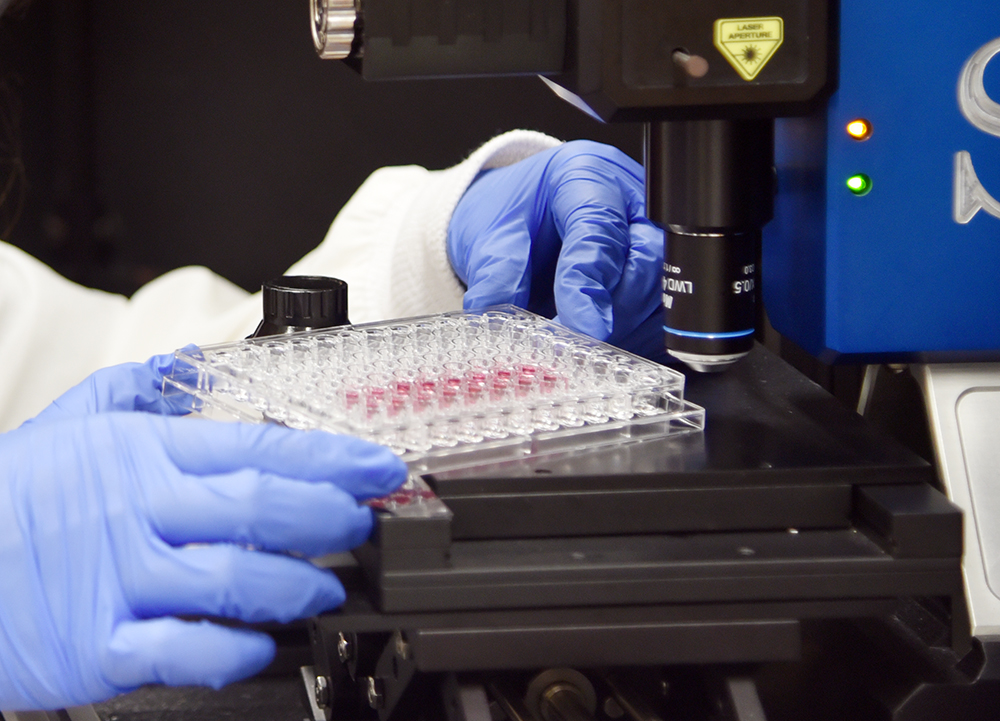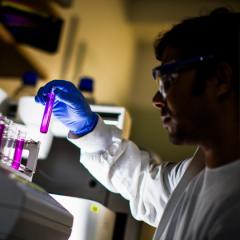UQ Researchers have developed a new nanotechnology to monitor drug resistance and diversity of individual cancer cells circulating in the body.

Jing Wang, a PhD student working in the laboratory of Professor Matt Trau at the Australian Institute for Bioengineering and Nanotechnology (AIBN), says that the new test not only has the potential to provide early diagnosis of a spreading cancer, but could also help guide clinical decisions.
Clinical translation involved a close collaboration with the laboratory of Prof Jonathan Cebon, Medical Director at the Olivia Newton John Cancer Research Institute in Melbourne. Dr Simon Tsao (now a practicing surgical oncologist) who performed the work while visiting the Trau laboratory at the AIBN tested the device against blood samples taken from melanoma patients during the course of cancer treatment.
“It’s a simple nanotechnology that looks at changes in circulating tumour cells before, during, and after treatment,” Wang says.
Circulating tumour cells (CTCs) are cancer cells that have been shed by the original tumour and have entered the bloodstream. CTCs enable cancers to spread by lodging in distant tissues and forming new tumours.
Detecting the presence and diversity of CTCs can indicate whether a cancer is attempting to spread, which has important clinical implications.
CTCs can be found by looking for distinctive proteins on their surface, but currently this process is time consuming and can typically only identify one type of CTC protein at a time. Furthermore the types of proteins on the surfaces of CTCs can vary from one type of cancer to another, and even within in the same cancer, says Wang. Therefore, if you go looking for CTCs by looking for just one kind of protein, or one type of CTC, you can miss a lot.

This is a big problem because there is a great deal of variation in CTCs. There is also a need to dramatically simplify the approach.
To address this problem, the Trau laboratory developed a simple read-out technology which utilises a special type of gold nanoparticle. Each nanoparticle is attached to an antibody that can stick to a specific protein on a CTC.
When these nanoparticles are hit with laser light, they give off a unique optical barcode signal that can be detected. If a nanoparticle encounters a CTC and sticks to it, this signal changes ever so slightly, and that change lets you know that a particular CTC is present.
Why gold? Nano-sized gold has a unique property in that it can enhance the signal, making any changes easier to detect.
Importantly, each nanoparticle can be linked with a different antibody. Thus when you combine a variety of nanoparticle-antibody pairs in one test, it’s possible to search for multiple types of CTCs at once.
The gold nanoparticle technology is extremely sensitive, too. It can detect as few as 10 CTCs in a 1 millilitre blood sample. This makes the technology extremely quick and easy to use.
“The special feature of this technology is the fact that it can accurately measure the diversity of CTCs in real-time, before, during and after treatment,” says Trau. “This is critical information for the oncologist to guide the treatment of the patient, and in the future could be developed into a simple hand-held device”.
The nanoparticle technology was able to successfully track in real-time how the diversity of tumour cell populations were changing in response to particular therapies for all of the patients studied. Remarkably, this “liquid biopsy” technology was both predictive and prognostic for all of the patients studied.
One of the big challenges in cancer medicine is that cancers can evolve over time; this includes developing resistance to treatment. This evolution is associated with changes on the cell surface.
With this technology, we can see very dramatic changes in the CTC diversity during treatment says Cebon, “Having information about these changes at a cellular level has the potential to guide cancer therapy in real-time, to identify signs of drug resistance and help doctors and patients make informed decisions about treatment strategy.”
“The technology could also greatly improve our ability to study how tumour cells change in response to treatment and could help answer important biological questions about how treatment resistance arises.”
The study was published in Nature Communications.
MEDIA – Professor Matt Trau, m.trau@uq.edu.au, 0412 560 343; AIBN Communications, communications@aibn.uq.edu.au; Julie McNamara, Olivia Newton John Cancer Research Institute, 0419 595 688.


